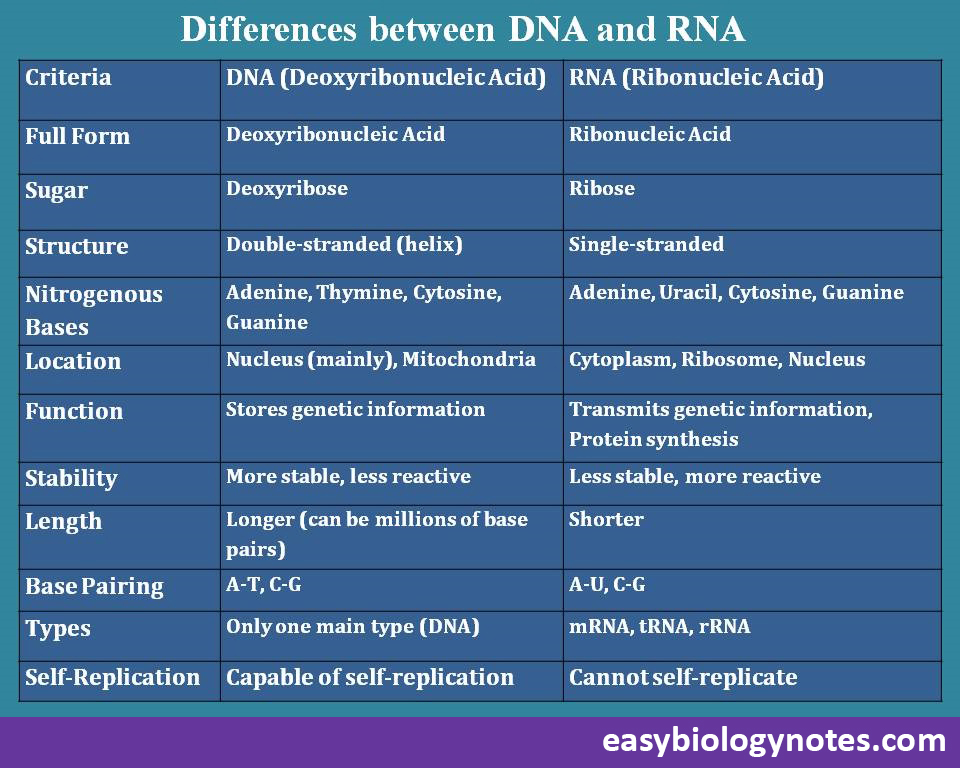What are the differences between DNA and RNA?
Following are the differences between DNA and RNA -:
| Criteria | DNA (Deoxyribonucleic Acid) | RNA (Ribonucleic Acid) |
| Full Form | Deoxyribonucleic Acid | Ribonucleic Acid |
| Sugar | Deoxyribose | Ribose |
| Structure | Double-stranded (helix) | Single-stranded |
| Nitrogenous Bases | Adenine, Thymine, Cytosine, Guanine | Adenine, Uracil, Cytosine, Guanine |
| Location | Nucleus (mainly), Mitochondria | Cytoplasm, Ribosome, Nucleus |
| Function | Stores genetic information | Transmits genetic information, Protein synthesis |
| Stability | More stable, less reactive | Less stable, more reactive |
| Length | Longer (can be millions of base pairs) | Shorter |
| Base Pairing | A-T, C-G | A-U, C-G |
| Types | Only one main type (DNA) | mRNA, tRNA, rRNA |
| Self-Replication | Capable of self-replication | Cannot self-replicate |
Conclusion on Differences Between DNA and RNA
DNA (Deoxyribonucleic Acid) and RNA (Ribonucleic Acid) are fundamental molecules that play critical roles in the storage, expression, and transmission of genetic information. While they share some structural and functional similarities, their differences are key to their unique roles in living organisms. The comparison between DNA and RNA can be further elaborated as follows:
1. Structural Differences
- DNA is a double-stranded molecule with a stable helical structure, whereas RNA is single-stranded and more flexible. This structural distinction allows DNA to be more robust and suited for long-term storage of genetic information. RNA’s single-stranded nature enables it to fold into various shapes, giving it functional diversity such as acting as a messenger, enzyme, or adaptor.
- The sugar component in DNA is deoxyribose, lacking one oxygen atom compared to ribose in RNA. This absence of oxygen makes DNA chemically more stable, which is necessary for preserving genetic integrity over long periods. In contrast, ribose in RNA makes it more reactive and suitable for temporary roles in protein synthesis and gene regulation.
2. Functional Roles
- DNA serves as the permanent repository of genetic information in almost all living organisms. Its primary function is to store instructions for building and maintaining an organism. RNA, on the other hand, acts as a bridge between DNA and proteins. Messenger RNA (mRNA) carries genetic instructions from DNA to ribosomes, transfer RNA (tRNA) helps in protein assembly, and ribosomal RNA (rRNA) forms a key structural and functional component of ribosomes.
- RNA also plays regulatory and catalytic roles that DNA cannot perform. For example, small RNA molecules regulate gene expression, while ribozymes (RNA with enzymatic activity) catalyze specific biochemical reactions.
3. Stability and Longevity
- DNA is more chemically stable and is found in the nucleus (and mitochondria in eukaryotic cells). Its stability ensures that genetic information is protected from environmental and enzymatic degradation. RNA, being less stable, is more transient and exists only for the duration needed to carry out its function. This transient nature prevents overaccumulation and allows for rapid adaptation to cellular needs.
4. Location and Synthesis
- DNA is primarily located in the nucleus, while RNA is synthesized in the nucleus but functions in the cytoplasm. The compartmentalization of DNA ensures that it is protected from potential damage in the cellular environment. RNA’s mobility allows it to act as a messenger and perform its various roles across cellular compartments.
5. Evolutionary Perspective
- DNA’s stability and error-checking mechanisms make it an ideal molecule for storing genetic information across generations. In contrast, RNA is believed to have evolved earlier than DNA, playing a central role in the ancient “RNA world.” Its ability to store information, act as a catalyst, and perform diverse functions underlines its evolutionary importance.
Summary
DNA and RNA are distinct yet complementary molecules integral to life. DNA’s stability and structure make it an ideal repository of genetic information, ensuring continuity across generations. RNA, with its versatility and functional diversity, plays a central role in gene expression and regulation. Understanding the differences between DNA and RNA is not only foundational in biology but also crucial for advancements in genetics, medicine, and biotechnology. Their interplay continues to reveal new insights into the molecular mechanisms of life, reinforcing the dynamic complexity of biological systems.
Some important points:
- Complementary Nature: The interplay between DNA and RNA is vital for the central dogma of molecular biology: DNA → RNA → Protein.
- Medical Relevance: RNA-based technologies, such as mRNA vaccines, highlight its utility in modern medicine, while mutations in DNA are central to genetic disorders and cancer.
- Biotechnological Applications: Both DNA and RNA are essential in genetic engineering, diagnostics, and therapeutic strategies. For example, CRISPR technology utilizes RNA to edit DNA precisely.
